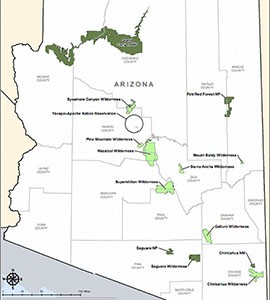Cronkite News has moved to a new home at cronkitenews.azpbs.org. Use this site to search archives from 2011 to May 2015. You can search the new site for current stories.
Feds order six plants to clear national park skies by cutting emissions
WASHINGTON – The Environmental Protection Agency set new limits Wednesday on emissions from six Arizona industrial facilities in order to reduce haze at 17 national parks and wilderness areas, including the Grand Canyon.
The final rule, published in Wednesday’s Federal Register, would cut more than 32,000 tons of pollutants each year from smelters, cement plants and a power plant to clear the air over “Class 1″ federal lands in Arizona, California, Utah and New Mexico. Twelve of those areas are in Arizona.
“The whole point of this is to improve visibility at national parks and wilderness areas,” said Thomas Webb, the regional haze program coordinator in EPA’s Region 9. “So people can see and enjoy them more because of less haze in the air.”
Advocates for the Grand Canyon, the most-famous of the 17 affected parks, welcomed the move but said it does not go far enough, noting that several coal-burning power plants in the state are not included in Wednesday’s rule.
“It’s a sign of progress,” said Roger Clark, Grand Canyon program director for the Grand Canyon Trust. “But the reality is the Navajo Generating Station and other power plants around it continue to cause haze at the Canyon every day.”
The facilities that were covered by Wednesday’s announcement include the Sundt Generating Station Unit 4, Nelson Lime Plant Kilns 1 and 2, the Hayden Smelter and Miami Smelter, which will be required to install Best Available Retrofit Technology (BART) controls to meet the lower emission standards.
Two other facilities – the Phoenix Cement Clarkdale Plant Kiln 4 and the CalPortland Cement Rillito Plant Kiln 4 – will be subject to “reasonable progress” restrictions.
The BART standards regulate the amount of nitrogen oxide, sulfur dioxide and particulate matter the facilities are allowed to release. Reasonable progress rules deal with nitrogen oxide emissions only.
Freeport-McMoRan, which operates the Miami smelter, said in a statement Wednesday that the company is “making the investment to comply with EPA’s National Ambient Air Quality Standards.”
“Once completed, the Miami smelter will meet the SO2 (sulfur dioxide) and NOx (nitrogen oxide) standards under the Clean Air Act’s Regional Haze Program,” the statement went on to say.
Calls seeking response from operators of the other facilities affected by the ruling were not immediately returned Wednesday.
The notice said the new emission guidelines will take effect Oct. 3.
“The companies have to decide how they’re going to meet the rules,” Webb said. “We aren’t telling them how to do it, we’re just telling them they have to do it.”
The Federal Register notice also said the EPA “would welcome a State plan to replace some or all of the Federal plan.” The Arizona Department of Environmental Quality did not return a call seeking comment.
But environmental groups welcomed the move, even if it was not all they wanted.
“What EPA is trying to do is absolutely a step in the right direction,” said Bill Snape, senior counsel at the Washington, D.C., office for the Center for Biological Diversity. “They probably should have gone even further. This is modest, but we’ll take modest steps, modest is better than nothing.”








